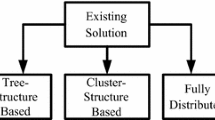Abstract
With the rapid development, Wireless Sensor Networks (WSNs) technology has been widely applied in many fields, such as military intelligence detection, medical condition detection, urban facility construction and smart home, etc. Clock synchronization is one of the key technologies in WSNs, precise node time synchronization is critical for many networked control applications in WSNs. Once the clock of sensor nodes loses synchronization, the information collected by nodes will lose timeliness and value for users. Therefore, the key technology of clock synchronization plays an important role in WSNs.
The main purpose of clock synchronization is to control the interval time that between sending and receiving timestamps of wireless sensor nodes within acceptable clock synchronization accuracy. However, because there are many kinds of link delays in the process of information transmission, the transmission time is prolonged and the time precision is reduced. Therefore, it is necessary to study the exact causes and effects of these errors. In ZigBee wireless sensor network, through theoretical model and data experimental analysis, we got the result that the random delay distributions of the uplink and downlink obey normal distribution when the sensor nodes exchange some information.














Similar content being viewed by others
References
Sun, Y. Q., Peng, J., Liu, T., & Chen, X. H. (2014). Uneven clustering routing protocol based on dynamic partition for wireless sensor network. Journal on Communications, 35(1), 198–206.
Azzabi, T., Farhat, H., Sahli, N. (2017). A survey on wireless sensor networks security issues and military specificities. In 2017 International Conference on Advanced Systems and Electric Technologies (IC_ASET), 2017:66–72.
Ghosh, K., Neogy, S., Das, P. K., & Mehta, M. (2018). Intrusion delection at internatonal borders and large military barracks with multi-sink wireless sentor networks: An energy solution. Wireless Personal Communications., 98(1), 1083–1101.
Mazhar Rathore, M., Ahmad, A., Paul, A., & Rho, S. (2016). Urban planning and building smart cities based on the internet of things using big analytics. Computer Networks., 101, 63–80.
Aroua, S., EI Korbi, I., Ghamri-Doudane, Y. (2017). A distributed cooperative spectrum resource allocation in smart home cognitive wireless sensor networks. In 2017 IEEE Symposium on Computers and Communications (ISCC), 2017:754–759.
Yi, W., Lo, K., Mak, T., Lenug, K., & Leung, Y. (2015). A survey of wireless sensor network based air pollution monitoring system. Sensors, 15(12), 1392–1427.
Sundararaman, B., Buy, U., & Kshemkalyani, A. (2005). Clock synchronization for wireless sensor networks: A survey. Ad Hoc Networks, 3(3), 281–323.
Elson, J., & Romer, K. (2003). Wireless sensor networks: A new regime for time synchronization. ACM SIGCOMM Computer Communication Review, 33(1), 149–154.
Maroti, M., Kusy, B., Simon, G., & Lédeczi, A. (2004). The flooding time synchronization protocol, In Proceedings of the 2004 2nd International Conference on Embedded Networked Sensor Systems, 2004:39–49.
Schenato, L., & Fiorentin, F. (2011). Average TimeSynch. A consensus-based protocol for clock synchronization in wireless sensor networks. Automatica, 47(9), 1878–1886.
He, J., Cheng, P., Shi, L., Chen, J., & Sun, Y. (2014). Time synchronization in WSNs: A maximum-value-based consensus approach. IEEE Transactions on Automatic Control, 59(3), 660–675.
Noh, K. L., Chaudhari, Q. M., Serpedin, E., & Suter, B. W. (2007). Novel clock phase offset and skew estimation using two-way timing message exchanges for wireless sensor networks. IEEE Transactions on Communications, 55(4), 766–777.
Yoon, S., Veerarittiphan, C., & Tiny-sync, S. M. L. (2007). Tight time synchronization for wirless sensor networks. ACM Transactions on Sensor Networks, 3(2), 8–20.
Gong, F., & Sichitiu, M. L. (2017). Temperature Compensated Kalman Distributed Clock Synchronization. Ad Hoc Networks, 62(2), 88–100.
Acknowledgements
This research is funded by Natural Science Foundation of Inner Mongolia Autonomous Region under Grant 2020MS06021, and Talent Development Fund of Inner Mongolia Autonomous Region.
Author information
Authors and Affiliations
Corresponding author
Additional information
Publisher's Note
Springer Nature remains neutral with regard to jurisdictional claims in published maps and institutional affiliations.
Rights and permissions
About this article
Cite this article
Wang, X., Yi, D. & Zhang, Z. Discovery of Random Delay Distribution Based on Complex WSNs Clock Synchronization. Wireless Pers Commun 119, 2487–2500 (2021). https://doi.org/10.1007/s11277-021-08340-3
Accepted:
Published:
Issue Date:
DOI: https://doi.org/10.1007/s11277-021-08340-3




